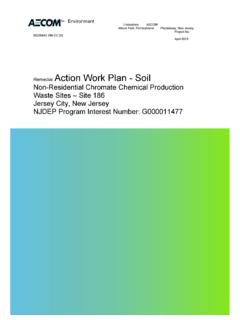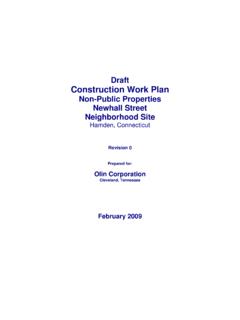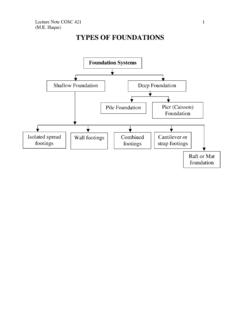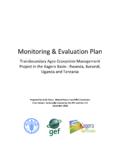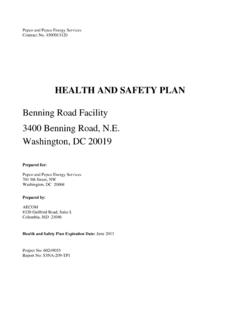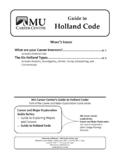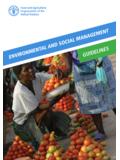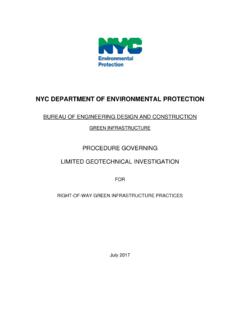Transcription of Red Cedar River Watershed Management Plan
1 Red Cedar River Watershed Management plan Submitted by: Michigan State University Institute of Water Research Originally Submitted November 6, 2014 Amended March 24, 2015 Amended June 25, 2015 MDEQ tracking code: #2011-0014 i ACKNOWLEDGEMENTS This document was developed with funding provided by a Clean Water Act, Section 319 grant from the Michigan Department of Environmental Quality (MDEQ), grant number 2011-0014. Financial and in-kind assistance was provided by Michigan State University (MSU). The Red Cedar River Watershed Management plan was written by: Erin Campbell, Tri-County Regional Planning Commission Ruth Kline-Robach, MSU Institute of Water Research (IWR) Kalie Nye, MSU Department of Community Sustainability Aaron Snell, Streamside Ecological Services The authors wish to acknowledge the following individuals who assisted in the development of the plan : Jason Piwarski, MSU-IWR and Joe Welsh, MSU-RSGIS, who created the GIS maps Lois Wolfson, MSU-IWR who assisted with data analysis and summarization Laura Young, MSU-IWR, who provided valuable design and editorial assistance In addition, the authors extend appreciation to the following communities, organizations, and agencies that contributed expertise, time and resources in support of the Watershed Management planning process.
2 City of East Lansing, City of Lansing, City of Williamston, Clinton Conservation District, Clinton County Drain Commissioner, Delhi Charter Township, Eaton Conservation District, Ingham Conservation District, Ingham County Drain Commissioner, Ingham County Health Department, Lansing Charter Township, Livingston County Drain Commissioner, Livingston County Health Department, Meridian Charter Township, Michigan Department of Environmental Quality, and Williamstown Township. ii TABLE OF CONTENTS 1. INTRODUCTION .. 1 Goal of Watershed Planning .. 1 Key Elements of Developing a WMP .. 2 Impaired and Threatened Designated Uses .. 2 2. DESCRIPTION OF THE RED Cedar River Watershed .. 3 Land Use .. 3 Geographic Scope .. 5 Topography .. 7 Geology .. 9 11 Climate .. 14 Upstream Watershed .. 14 Hydrology .. 14 Aquatic Life .. 19 Protected Species .. 19 Invasive Species .. 19 Recreational Uses and Government Protected Lands .. 20 Political Jurisdictions.
3 22 Demographics .. 24 3. WATER QUALITY IN THE RED Cedar River Watershed AN 26 Designated Uses .. 26 Pollutants that May Impair or Threaten Designated Uses .. 27 Data Collection and Analysis .. 33 4. DESCRIPTION OF RED Cedar River SUBWATERSHEDS .. 53 Coon Creek .. 55 Deer Creek .. 57 Dietz Creek .. 58 Doan Creek .. 59 Handy Drain No. 5 .. 61 Handy Howell Drain .. 62 Hayhoe Drain Doan Creek .. 63 Headwaters Sycamore Creek .. 64 Headwaters West Branch Red Cedar River .. 66 iii Kalamink Creek .. 67 Middle Branch Red Cedar River .. 69 Mud Creek .. 70 Pine Lake Outlet .. 72 Red Cedar River .. 73 Sloan Creek .. 76 Squaw Creek .. 77 Sycamore Creek .. 79 West Branch Red Cedar River .. 82 Wolf Creek .. 83 5. GOALS AND OBJECTIVES OF THE Watershed .. 86 Goals for the Red Cedar River Watershed .. 86 Objectives to Meet the Watershed Goals .. 86 6. POLLUTANTS, SOURCES, CAUSES AND BEST Management PRACTICES .. 88 Pollutant: E. coli .. 89 Pollutant: Sediment.
4 100 Pollutant: Nutrients .. 103 7. STRUCTURAL BMP IMPLEMENTATION plan .. 114 Pollutant Loadings and Reduction Goals to Meet TMDL Goals .. 114 Pollutant Loading and Reduction Goals for Other Pollutants .. 114 Priority Areas for Preservation and Protection .. 115 Restoring Critical Sites .. 117 Restoring Critical Areas .. 119 Subwatershed Prioritization .. 121 Funding BMPs .. 125 Implementation Schedule and Milestones .. 125 8. INFORMATION AND EDUCATION STRATEGY .. 126 Survey Data .. 126 Goals and Objectives of I/E Strategy .. 127 Developing Messages .. 128 Selecting Delivery Mechanisms and Activities .. 128 Regional Collaboration and Partnerships .. 128 Implementation of I/E Strategy .. 131 MDEQ Funding Acknowledgement .. 135 Evaluation Measures .. 135 iv 9. SUSTAINABILITY .. 136 Existing Structure .. 136 Local Partners .. 138 Local Policy Review of Codes and Ordinances .. 141 Measuring Progress and Monitoring Water Quality .. 141 WMP Implementation plan and Updates.
5 144 References .. 145 v List of Figures Figure Land Use Land Cover .. 4 Figure Subwatershed Boundaries .. 6 Figure Topography .. 8 Figure Geology .. 10 Figure Hydrologic Soil Groups .. 13 Figure Floodplains .. 16 Figure Existing Wetlands .. 18 Figure Government Protected Land .. 21 Figure Local Units of Government .. 23 Figure Population Density by Subwatershed .. 25 Figure Red Cedar River Watershed E. coli TMDL .. 28 Figure Red Cedar River Dissolved Oxygen TMDL .. 30 Table Target Values Used to Assess Pollutants of Concern .. 32 Figure E. coli Monitoring Locations .. 34 Figure ICHD 2013 E. coli Geomean vs. Date .. 37 Figure ICHD 2012 E. coli Geomean vs. Date .. 39 Figure MSU 2012 E. coli Geomean vs. Date .. 41 Figure Conservation District 2013 E. coli Geomean vs. Date .. 43 Figure Microbial Source Tracking .. 46 Figure HIT modeling results .. 48 Figure Microbial Source Tracking .. 94 Figure Nonpoint source sites.
6 95 Figure Animal Operations .. 96 Figure Cropland .. 97 Figure Manure Spreading locations .. 98 Figure Septic System Density by Subwatersheds .. 99 Figure HIT modeling results in tons of sediment per acre delivered to surface water per year . 101 Figure Priority Areas for Conservation .. 116 Figure Critical Sites for Restoration .. 118 Figure Critical Areas for Wetland Restoration .. 120 vi List of Tables Table Land Use in the Red Cedar River Watershed .. 3 Table : Hydrologic Soil Groups .. 11 Table Red Cedar River Watershed Soils .. 12 Table Red Cedar River Watershed E. coli TMDL AUIDs .. 27 Table Target Values Used to Assess Pollutants of Concern .. 32 Table Stream Depth .. 35 Table Averaged data from the Main Branch of the Red Cedar River .. 44 Table Averaged data within subwatersheds of the Red Cedar River .. 45 Table Red Cedar River Watershed Wetland Resources Status and Trends .. 51 Table Pollutant Loadings by 54 Table Pollutant, Source, Cause Summary.
7 107 Table Best Management Practices for Pollutants and Sources .. 110 Table Critical Sites for Restoration .. 117 Table Subwatershed Ranking Matrix .. 123 Table Subwatershed Tier Prioritization .. 123 Table I/E Implementation .. 134 Table Proposed Water Quality Monitoring Activities .. 143 vii List of Appendices Appendix A Stakeholders and Partners Appendix B Quality Assurance Project plan Appendix C Summary 2012-2013 E coli. Data by Agency Appendix D Windshield Survey Methodology Appendix E Red Cedar River Landscape level functional wetland asssessment Appendix F Policy Matrix viii List of Acronyms ACEP Agricultural Conservation Easement Program AUID Assessment Unit Identitication BMP Best Management practice CAFO Concentrated animal feeding operation C-CAP Coastal Change Analysis Program CD Conservaiton district CFU Colony forming unit COD Chemical oxygen demand DC Drain commissioner DO Dissolved oxygen E. coli Escherichia coli ECD Eaton Conservation District EQIP Environmental Quality Incentives Program FIRM Flood Insurance Rate Maps FORC Friends of the Red Cedar GIS Geographic information system GLRC Greater Lansing Regional Committee for Stormwater Management GMM Green Mid-Michigan HIT High Impact Targeting model HUC Hydrologic Unit Code HUD United States Department of Housing and Urban Development I/E Information and education ICD Ingham Conservation District ICHD Ingham County Health Department IWR Institute of Water Research LCD Livingston Conservation District LCDH Livingston County Health Department LLFWA Landscape level functional wetland asssessment MAEAP Michigna Agricultural Environmental Assurance Program MDARD Michigan Department of Agriculture and Rural Development MDEQ Michigan Department of Environmental Quality MDNR Michigan Department of Natural Resources MGROW Middle Grand River of Watersheds MGRWP Middle Grand River Watershed Planning Project Mid-MEAC
8 Mid-Michigan Environmental Action Council MMPGS Mid-Michigan Program for Greater Sustainability MNFI Michigan Natureal Features Inventory MS4 Municipal separate storm sewer systems MSU Michigan State University NOAA National Oceanic and Atmospheric Administration NPDES National Pollutant Discharge Elimination System NRCS Natural Resources Conservation Service NREPA Natural Resources Enviornmental Protection Act NSA Neighborhood source assessment PBC Partial Body Contact PCA Potential Conservation Area PEP Public Education plan QAPP Quality Assurance Project plan RCPP Regional Conservation Partnership Program RCRW Red Cedar River Watershed SCD Shiawasee Conservation District SIDMA Social Indicators Data Management and Analysis SMNITP Southern Michigan Northern Indiana Till Plains TBC Total Body Contact ix TCRPC Tri-County Regional Planning Commission TDS Total dissolved solids TMDL Total maximum daily load TOC Total organic carbon TSS Total suspended solids EPA United States Environmental Protection Agency USDA FSA United States Department of Agriculture Farm Service Agency USGS United States Geological Survey WMP Watershed Management plan WQS Water quality standards WWTP Wastewater treatment plant 1 1.
9 INTRODUCTION The Red Cedar River originates near Cedar Lake, which is located in the southwestern corner of Livingston County, in the south-central portion of the Lower Peninsula. The River flows in a westerly direction for about 51 miles from the area surrounding Cedar Lake, into Ingham County, through Meridian Township, the City of East Lansing and the campus of Michigan State University, and into Lansing, where it joins the Grand River (MDTMB, 2012). The Red Cedar River Watershed (RCRW) (Hydrologic Unit Code 04050004) (see Figure ), is approximately 294,496 acres (461 sq. miles) and land use in the Watershed area is varied. The Red Cedar River has West and Middle Branches, which also originate in southern Livingston County. The RCRW contains a diverse mix of rural lands dominated by agricultural land use and small communities, suburban areas and highly urbanized lands. The Watershed is home to thousands of residents who live, learn, work and recreate within its lands and waters.
10 Farms, factories and shopping malls are necessary for our quality of life. Equally important are clean water for fishing, swimming and drinking, and natural landscapes for aesthetic relief. The River and its Watershed are also home to a myriad of plants and animals that rely on a clean, protected environment to flourish. This Watershed Management plan (WMP) was developed for the protection of lands and waters of the RCRW. It was developed to serve as a guide for protecting and improving the waters that bisect the landscape, flowing adjacent to our homes, under our roads and through our farms. This WMP is authored by the RCRW Management team, comprised of representatives from the Michigan State University (MSU) Institute of Water Research (IWR); Streamside Ecological Services, Inc.; and the Tri-County Regional Planning Commission (TCPRC). The Management team coordinated and guided all efforts related to the planning process and overall WMP development, including stakeholder engagement.
